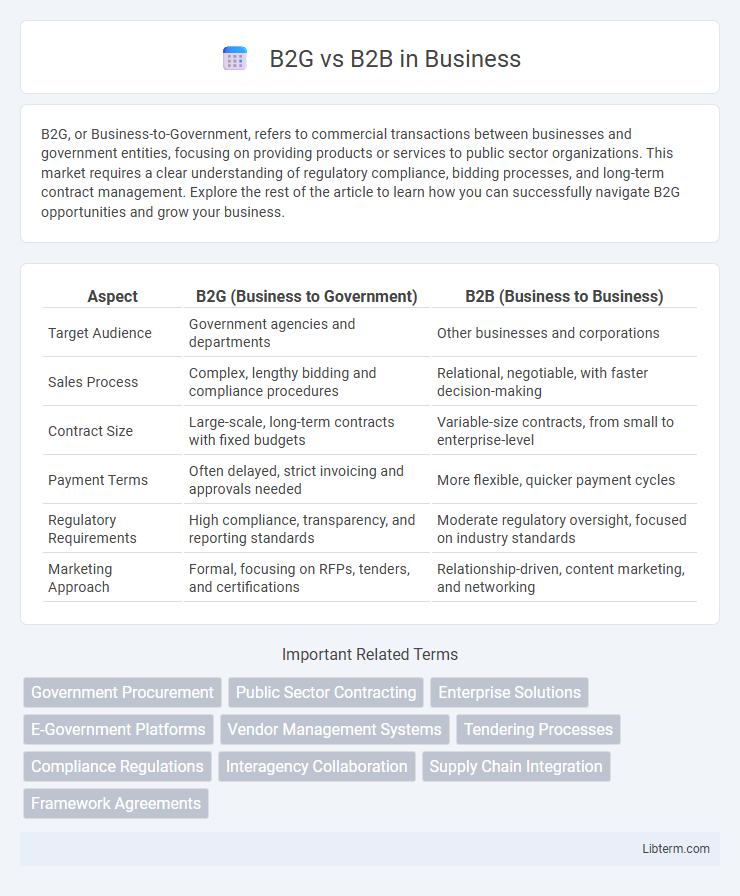B2G, or Business-to-Government, refers to commercial transactions between businesses and government entities, focusing on providing products or services to public sector organizations. This market requires a clear understanding of regulatory compliance, bidding processes, and long-term contract management. Explore the rest of the article to learn how you can successfully navigate B2G opportunities and grow your business.
Table of Comparison
| Aspect | B2G (Business to Government) | B2B (Business to Business) |
|---|---|---|
| Target Audience | Government agencies and departments | Other businesses and corporations |
| Sales Process | Complex, lengthy bidding and compliance procedures | Relational, negotiable, with faster decision-making |
| Contract Size | Large-scale, long-term contracts with fixed budgets | Variable-size contracts, from small to enterprise-level |
| Payment Terms | Often delayed, strict invoicing and approvals needed | More flexible, quicker payment cycles |
| Regulatory Requirements | High compliance, transparency, and reporting standards | Moderate regulatory oversight, focused on industry standards |
| Marketing Approach | Formal, focusing on RFPs, tenders, and certifications | Relationship-driven, content marketing, and networking |
Understanding the Differences: B2G vs B2B
B2G (Business-to-Government) involves transactions between companies and government agencies, emphasizing regulatory compliance, public procurement procedures, and long-term contracts. B2B (Business-to-Business) focuses on commercial transactions between companies with priorities like efficiency, customization, and relationship management. Understanding the differences in decision-making processes, contract requirements, and sales cycles is essential for businesses targeting either government entities or private sector firms.
Key Characteristics of B2G and B2B Markets
B2G (Business-to-Government) markets involve long sales cycles, stringent regulatory compliance, and complex procurement processes driven by public sector policies and budget constraints. B2B (Business-to-Business) markets prioritize relationship-building, customization, and efficiency, with faster decision-making influenced by return on investment and competitive advantage. Both markets demand strategic targeting, but B2G emphasizes transparency and adherence to government standards, while B2B focuses on innovation and scalability.
Sales Cycles: B2G vs B2B Processes
B2G sales cycles are typically longer due to extensive government procurement regulations, compliance requirements, and multiple approval layers, often spanning several months to years. B2B sales processes tend to be shorter and more flexible, driven by business needs, budgets, and market competition, usually concluding within weeks to a few months. The complexity and formality of B2G negotiations emphasize transparency and documentation, whereas B2B interactions prioritize relationship-building and dynamic decision-making.
Target Audience Analysis for B2B and B2G
Target audience analysis in B2B focuses on identifying industry-specific decision-makers such as procurement officers, C-level executives, and department managers within private enterprises, emphasizing their needs for efficiency, ROI, and competitive advantage. In B2G, the target audience includes government officials, agency administrators, and public sector procurement specialists who prioritize compliance with regulations, budget constraints, and long-term public impact. Understanding these distinct audiences guides tailored marketing strategies, addressing unique purchasing processes and decision-making hierarchies in both sectors.
Procurement and Decision-Making in B2G and B2B
Procurement in B2G (Business-to-Government) typically involves strict regulatory compliance, extended bidding processes, and transparency to ensure fairness, whereas B2B (Business-to-Business) procurement emphasizes flexibility, negotiation, and relationship-driven decision-making. Decision-making in B2G is often centralized, with multiple layers of approval influenced by government policies and public accountability, contrasting with B2B's decentralized, faster decisions driven by business goals and competitive advantage. Understanding these distinctions is crucial for tailoring strategies that align with the procurement cycles and stakeholder priorities in each sector.
Challenges Unique to B2G Compared to B2B
B2G (Business-to-Government) transactions face unique challenges compared to B2B (Business-to-Business) interactions, including stringent compliance with complex regulatory frameworks and lengthy procurement cycles driven by public sector policies. B2G engagements require transparency and adherence to strict ethical standards, often involving competitive bidding processes and detailed documentation. Additionally, payment delays and budgetary constraints in government agencies create cash flow uncertainties that are less prevalent in typical B2B contracts.
Marketing Strategies for B2G vs B2B
Marketing strategies for B2G (Business to Government) focus on compliance, building long-term relationships, and navigating procurement processes, often requiring detailed proposals and adherence to regulatory standards. B2B (Business to Business) marketing emphasizes lead generation, showcasing ROI, and personalized engagement through content marketing, networking, and account-based marketing tactics. Both sectors rely on trust and credibility, but B2G demands more formal documentation and qualification stages, whereas B2B prioritizes dynamic interactions and competitive differentiation.
Compliance and Regulations in B2G and B2B
Compliance and regulations in B2G (Business-to-Government) are stringent, requiring businesses to adhere to specific government standards, procurement rules, and security protocols that vary by jurisdiction. In contrast, B2B (Business-to-Business) compliance focuses on industry standards, contract obligations, and regulatory requirements pertinent to private sector operations, such as data privacy laws like GDPR or industry-specific certifications. Understanding the distinct regulatory frameworks in B2G and B2B is essential for mitigating legal risks and ensuring successful contracts within both government and commercial markets.
Opportunities for Growth in B2G and B2B
B2G (Business-to-Government) offers significant growth opportunities through large-scale contracts, long-term partnerships, and access to government funding and incentives, driving stable revenue streams. B2B (Business-to-Business) growth potential stems from diversified client portfolios, innovation-driven product development, and scalability across various industries, enhancing market reach and operational efficiency. Both models benefit from leveraging digital transformation and data analytics to optimize customer engagement and streamline procurement processes.
Choosing Between B2G and B2B for Your Business
Choosing between B2G and B2B depends on your target market, sales cycle, and product offering. B2G involves selling to government entities, requiring compliance with strict regulations, longer procurement processes, and often larger contract values. B2B targets other businesses, typically offering faster sales cycles, diverse client needs, and flexibility in product customization.
B2G Infographic

 libterm.com
libterm.com